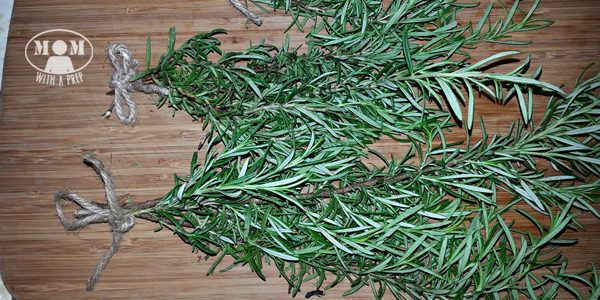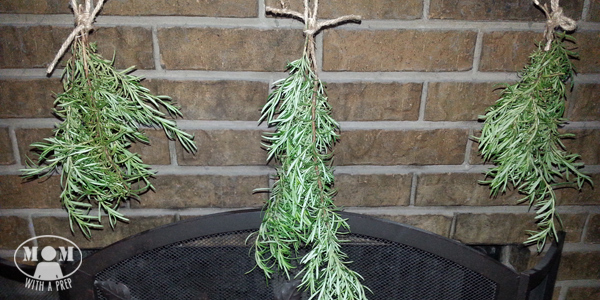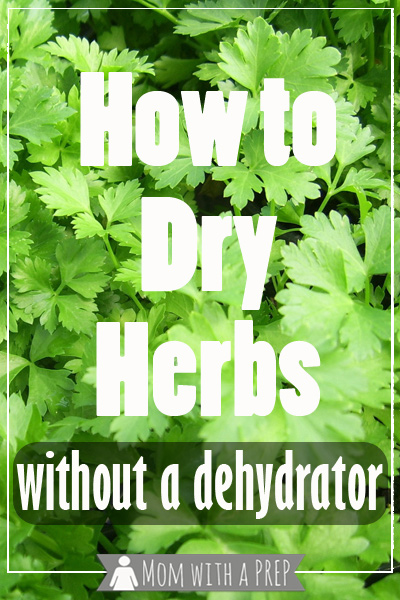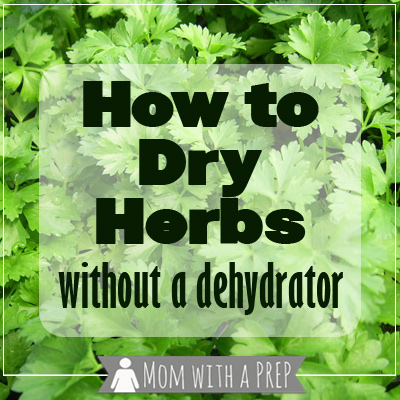During the summer, when I had herbs in my garden, I had parsley coming out my eyeballs. I made some pesto parsley, used a lot to flavor dishes fresh and froze some*. I still had a ton left over, so I thought I’d give drying a try. So I clipped some parsley, hung it upside down on a clothesline in my laundry room for about a week, rubbed it between my hands, and stored it in my parsley tin. It was wonderful. It wasn’t brown and weird like the stuff from the grocery store in a jar. It smelled wonderful, had a bold taste, and was sorely missed when I ran out of it. Our summer crops had been tilled under, I had no more drying on the line, and I was out! I didn’t want to go back to the stuff from a jar, ever!
How to Dry Herbs Without Electricity
So, when shopping for produce a few weeks ago, I picked up a couple of more bundles of parsley. I kept one bundle in the fridge to use fresh (stored in a zip top bag wrapped in a moist paper towel), then separated the other two bundles into smaller ones, and used some twist ties to tie the bundles together, and formed a loop on one end to hang off my clothesline in my laundry room. This gave each bundle plenty of space to allow the air to move through the leaves well, instead of having a barrier and not drying well. A week later, I had a huge stock of dried parsley that smells wonderful and tastes great..and it’s not brown like the stuff that comes out of the bottle!
This trick on how to dry herbs without electricity can be used for almost any herb.
How to Dry Parsley or any Herb – without electricity!
- Wash your flat leaf parsley and allow to dry. If you have a salad spinner, this is a great way to quickly dry your parsley. I use a tea towel to pat the leaves dry, then allow them to air dry.
- Separate large bundles into smaller packets.
- Use string to tie up the loose bundles, or twist ties. Use one end of string or twist tie to tie bundle together, and form a hook with the other end to hang on a line, a hangar or any other place you have great air circulation and the parsley won’t be in the way.
- Check occasionally to be sure it’s drying well. After a few days, your parsley should be ready to process. I usually leave mine up for at least a week to make sure they’re fully dried.
- Take each bundle and rub gently between your hands over a tea towel or paper towel. Pick out any bits of stem.
- Store in an airtight container, preferably out of the light which can make the herbs degrade more quickly.
Here’s an example of air drying rosemary
Bundle:

Hang to dry:
DRYING RACK: You can build a simple drying rack from 1×1’s and windows screen material stapled to it. Then lay out your herbs in single layers. You can put a block between screen squares and stack them. This works similarly to hanging them, but takes up a bit more room.
OVEN VERSION – there is a way to do this in your oven. Set it on it’s lowest temperature, lay out your herbs on a grill or tray, close the door, but put a glove or something in the door so it stays open. You want to allow the heat to escape so as not to cook the herbs – just dry them. You’ll have to check often to see if they are dry enough as all herbs take different amounts of time depending on what they are. It may take 3-4 hrs, but check often.
MICROWAVE VERSION – You can layer the herbs in paper towels inside the microwave and process for 1-3 minutes, testing as you go. I do not recommend this way because this is still cooking through the way it would do food, instead of just removing the moisture. Besides, I’m not a big fan of a microwave, so there is bias there 🙂
*Another way to keep parsley ‘fresh’ for your cooking is to chop it and freeze it in small bits of water in ice cube trays. It won’t be as fresh as the fresh stuff, but tossed into soups at the last minute gives you that fresh flavor, even in the dead of winter if you can’t grow it for yourself.
You can do this for just about any herb that you can grow. You don’t always have to crush the leaves, as with something like rosemary, but as long as they have free air movement, most herbs will dry this way. Some may take longer than others, so just keep an eye on them. If you’re worried about dust, tie your herb bundles inside of a paper bag to help protect them. You can also dry in the oven, but I found that I tended to burn them because I didn’t keep a close enough eye on them.
However, if you can use a dehydrator, do it! It makes it all so much easier!

Katy Willis is a writer, lifelong homesteader, and master herbalist, master gardener, and canine nutritionist. Katy is a preparedness expert and modern homesteader practicing everyday preparedness, sustainability, and a holistic lifestyle.
She knows how important it is to be prepared for whatever life throws at you, because you just never know what's coming. And preparedness helps you give your family the best chance to thrive in any situation.
Katy is passionate about living naturally, growing food, keeping livestock, foraging, and making and using herbal remedies. Katy is an experienced herbalist and a member of the CMA (Complementary Medical Association).
Her preparedness skills go beyond just being "ready", she's ready to survive the initial disaster, and thrive afterward, too. She grows 100% organic food on roughly 15 acres and raises goats, chickens, and ducks. She also lovingly tends her orchard, where she grows many different fruit trees. And, because she likes to know exactly what she's feeding her family, she's a seasoned from-scratch cook and gluten-free baker.
Katy teaches foraging and environmental education classes, too, including self-sufficient living, modern homesteading, seed saving, and organic vegetable gardening.
Katy helps others learn forgotten skills, including basic survival skills and self-reliance.
She's been published on sites such as MSN, Angi, Home Advisor, Family Handyman, Wealth of Geeks, Readers Digest, and more.



